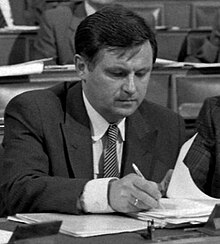Miklós Németh (politician)
Miklós Németh [ ˈmikloːʃ ˈneːmɛt ] (born January 14, 1948 in Monok ) is a Hungarian politician and was Hungarian Prime Minister from November 23, 1988 to May 23, 1990. He belonged to the reform wing of the Hungarian Socialist Workers' Party (Hungarian: Magyar Szocialista Munkáspárt , MSZMP).
General
Nemeth was born the son of a small farmer.
He studied economics (graduated in Budapest in 1971). From 1981 he was an employee (from 1986 department head) of the economic policy department of the Central Committee of the ruling Hungarian Socialist Workers Party.
Nemeth became Prime Minister of Hungary in November 1988. During his tenure in office, he contributed to the fall of the Iron Curtain by not having the ailing Hungarian border installations on the border with Austria cost-intensive renovation but dismantling from May 1989 . This enabled, among other things, many GDR citizens to flee to Austria, and thus further to the Federal Republic of Germany, and is also considered to be a trigger for the fall of the Berlin Wall . During his reign, Imre Nagy was rehabilitated and the Hungarian Republic was proclaimed on October 23, 1989.
After leaving the post of Prime Minister (May 1990), Németh became Vice President of the European Bank for Reconstruction and Development . He held this office until 2000. Then he failed in the attempt to become the prime minister candidate for the Hungarian Socialist Party (Hungarian: Magyar Szocialista Párt, MSZP) in the 2002 elections, his opponent Péter Medgyessy finally won the election.
Miklós Németh was appointed by the United Nations Development Program (UNDP) on September 11, 2007 as head of the new committee that monitors the activities of the North Korean authorities. The committee will complement the work of the UN Board of Auditors, which began its work in January 2007 at the request of UN Secretary-General Ban Ki-moon. In 2014 he was awarded the Point Alpha Prize .
Web links
- Miklós Németh in the Munzinger archive ( beginning of article freely available)
- Interview with Miklós Németh, former Prime Minister D., on the Hungarian reform process and the opening of the border 15 years ago (PDF)
See also
Footnotes
| personal data | |
|---|---|
| SURNAME | Németh, Miklós |
| BRIEF DESCRIPTION | Hungarian Prime Minister (1988–1990) |
| DATE OF BIRTH | January 14, 1948 |
| PLACE OF BIRTH | Monok , Hungary |
